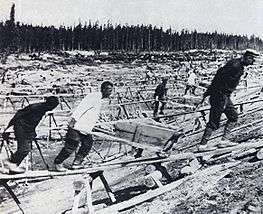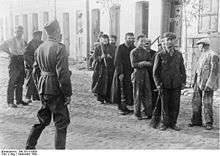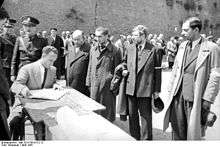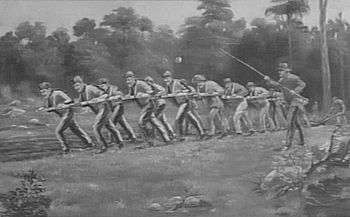Labor camp
A labor camp (or labour, see spelling differences) or work camp is a detention facility where inmates are forced to engage in penal labor as a form of punishment. Labor camps have many common aspects with slavery and with prisons (especially prison farms). Conditions at labor camps vary widely depending on the operators. Convention no. 105 of the United Nations International Labour Organization (ILO), adopted internationally on 27 June 1957, abolished camps of forced labor.[1]

In the 20th century, a new category of labor camps developed for the imprisonment of millions of people who were not criminals per se, but political opponents (real or imagined) and various so-called undesirables under communist and fascist regimes, both totalitarian. Some of those camps were dubbed "reeducation facilities" for political coercion, but most others served as backbones of industry and agriculture for the benefit of the state, especially in times of war.
Precursors
Early-modern states could exploit condemned dissidents and those of suspect political or religious ideology by combining prison and useful work in manning their galleys.[2] This became the sentence of many Christian captives in the Ottoman Empire[3] and of Calvinists (Huguenots) in pre-Revolutionary France.[4]
Labor camps in the 20th century
- Communist Albania
- The Allies of World War II operated a number of work camps after the war. At the Yalta Conference in 1945, it was agreed that German forced labor was to be utilized as reparations. The majority of the camps were in the Soviet Union, but more than one million Germans were forced to work in French coal-mines and British agriculture, as well as 500,000 in US-run Military Labor Service Units in occupied Germany itself.[5] See Forced labor of Germans after World War II.
- Communist Bulgaria
- Burma
- According to the New Statesman, Burmese military government operated, from 1962 to 2011, about 91 labour camps for political prisoners.[6]
- The anti-communist Kuomintang operated various camps between 1938 and 1949, including the Northwestern Youth Labor Camp for young activists and students.[7]
- The Communist Party of China has operated many labor camps for some crimes at least since taking power in 1949. Many leaders of China were put into labor camps after purges, including Deng Xiaoping and Liu Shaoqi. May Seventh Cadre Schools are an example of Cultural Revolution-era labor camps. According to CNN, hundreds — if not thousands — of labor camps and forced-labor prisons (laogai) still exist in modern-day China,[8] housing political prisoners and dissidents alongside dangerous criminals.
- The Standing Committee of the National People's Congress of the People’s Republic of China, which closed on December 28, 2013, passed a decision on abolishing the legal provisions on reeducation through labor.
- Beginning in November 1965, people classified as "against the government" were summoned to work camps referred to as "Military Units to Aid Production" (UMAP).[9]
- Communist Czechoslovakia
- After the communists took over Czechoslovakia in 1948, many forced labor camps were created. The inmates included political prisoners, clergy, kulaks, Boy Scout leaders and many other groups of people that were considered enemies of the state. About half of the prisoners worked in the uranium mines.[10] These camps lasted until 1961.
- Also between 1950 and 1954 many men were considered "politically unreliable" for compulsory military service, and were conscripted to labour battalions (Czech: Pomocné technické prapory (PTP)) instead.
- During the colonisation of Libya the Italians deported most of the Libyan population in Cyrenaica to concentration camps and used the survivors to build in semi-slave conditions the coastal road and new agricultural projects.[11]


- During World War II the Nazis operated several categories of Arbeitslager (Labor Camps) for different categories of inmates. The largest number of them held Jewish civilians forcibly abducted in the occupied countries (see Łapanka) to provide labor in the German war industry, repair bombed railroads and bridges or work on farms. By 1944, 19.9% of all workers were foreigners, either civilians or prisoners of war.[12]
- The Nazis employed many slave laborers. They also operated concentration camps, some of which provided free forced labor for industrial and other jobs while others existed purely for the extermination of their inmates. A notable example is the Mittelbau-Dora labor camp complex that serviced the production of the V-2 rocket. See List of German concentration camps for more.
- The Nazi camps played a key role in the extermination of millions.
- Imperial Japan
- During the early 20th century, the Empire of Japan used the forced labor of millions of civilians from conquered countries and prisoners of war, especially during the Second Sino-Japanese War and the Pacific War, on projects such as the Death Railway. Hundreds of thousands of people died as a direct result of the overwork, malnutrition, preventable disease and violence which were commonplace on these projects.
- North Korea is known to operate six camps with prison-labor colonies in remote mountain valleys. The total number of prisoners in the Kwan-li-so is 150,000 to 200,000. Once condemned as a political criminal in North Korea, the defendant and his family are incarcerated for life in one of the camps without trial and cut off from all outside contact.[13]
- See also: North Korean prison system
- Communist Romania
- Russia and Soviet Union
- Imperial Russia operated a system of remote Siberian forced labor camps as part of its regular judicial system, called katorga.
- The Soviet Union took over the already extensive katorga system and expanded it immensely, eventually organizing the Gulag to run the camps. In 1954, a year after Stalin's death, the new Soviet government of Nikita Khrushchev began to release political prisoners and close down the camps. By the end of the 1950s, virtually all "corrective labor camps" were reorganized, mostly into the system of corrective labor colonies. Officially, the Gulag was terminated by the MVD order 20 of January 25, 1960.[14]
- During the period of Stalinism, the Gulag labor camps in the Soviet Union were officially called "Corrective labor camps". The term "labor colony"; more exactly, "Corrective labor colony", (Russian: исправительно-трудовая колония, abbr. ИТК), was also in use, most notably the ones for underaged (16 years or younger) convicts and captured besprizorniki (street children, literally, "children without family care"). After the reformation of the camps into the Gulag, the term "corrective labor colony" essentially encompassed labor camps.
- Russian Federation
- 14 labor camps were operated by the Swedish state during World War II. The majority of internees were communists, but radical social democrats, syndicalists, anarchists, trade unionists, anti-fascists and other "unreliable elements" of Swedish society, as well as German dissidents and deserters from the Wehrmacht, were also interned. The internees were placed in the labor camps indefinitely, without trial, and without being informed of the accusations made against them. Officially, the camps were called "labor companies" (Swedish: arbetskompanier). The system was established by the Royal Board of Social Affairs and sanctioned by the third cabinet of Per Albin Hansson, a grand coalition which included all parties represented in the Swedish Riksdag, with the notable exception of the Communist Party of Sweden.

- After the war, many former camp inmates had difficulty finding a job, since they had been branded as "subversive elements".[15]
- In 2005, The United States Army declassified a document that "provides guidance on establishing prison camps on [US] Army installations." [21]
- Communist Yugoslavia
- The Goli Otok prison camp for political opponents ran from 1946 to 1956.
Labor camps in the 21st century
- According to CNN, hundreds — if not thousands — of labor camps and forced-labor prisons (laogai) still exist in modern day China (1984),[8] housing political prisoners and dissidents alongside dangerous criminals.
- The Standing Committee of the National People's Congress of the People’s Republic of China, which closed on December 28, 2013, passed a decision on abolishing the legal provisions on reeducation through labor. Penal labor continues to exist in Xinjiang re-education camps.[22]
- North Korea is known to operate six camps with prison-labor colonies in remote mountain valleys. The total number of prisoners in the Kwan-li-so is 150,000 – 200,000. Once condemned as a political criminal in North Korea, the defendant and his family are incarcerated for lifetime in one of the camps without trial and cut off from all outside contact.[13]
- See also: North Korean prison system
See also
- Chain gang
- Civilian Inmate Labor Program
- Extermination through labor
- Memorial (society)
- Penal colony
References
- Edmund Jan Osmańczyk & Anthony Mango (2003). Encyclopedia of the United Nations and International Agreements: G to M. International relations: Volume 2. Taylor & Francis. p. 1248. ISBN 0415939224 – via Google Books.CS1 maint: uses authors parameter (link)
-
Gibson, Mary; Poerio, Ilaria (2018). "Modern Europe, 1750-1950". In Anderson, Clare (ed.). A Global History of Convicts and Penal Colonies. Bloomsbury Publishing. ISBN 9781350000698. Retrieved 2019-10-07.
A second early modern form of punishment, the galleys, constituted a more direct precedent to the earliest hard labour camps. [...] Galley rowing offered no promise of rehabilitation and, in fact, often led to disease and death. However, it shared with the prison workhouses of northern Europe a new aspiration to integrate hard labour into punishment for the eeconomic benefit of the state.
-
Magocsi, Paul Robert (1996). A History of Ukraine: The Land and Its Peoples (2 ed.). Toronto: University of Toronto Press (published 2010). p. 185. ISBN 9781442698796. Retrieved 2019-10-07.
And what happened to the captives from Ukraine [...]? The slaves functioned at all levels of Ottoman society [...]. At the lowest end of the social scale were galley slaves conscripted into the imperial naval fleet and field hands who labored on Ottoman landed estates.
-
van Ruymbeke, Bertrand (2005). "'A Dominion of True Believers Not a Republic for Heretics': French Colonial Religious Policy and the Settlement of Early louisiana, 1699-1730". In Bond, Bradley G. (ed.). French Colonial Louisiana and the Atlantic World. Baton Rouge: Louisiana State University Press. p. 90. ISBN 9780807130353. Retrieved 2019-10-07.
Andre Zysberg's study shows that [...] nearly 1,500 Huguenots were sentenced to the galleys between 1680 and 1716 [...].
- John Dietrich, The Morgenthau Plan: Soviet Influence on American Postwar Policy (2002) ISBN 1-892941-90-2
- "Burma's forced labour". www.newstatesman.com.
- Mühlhahn, Klaus (2009). Criminal Justice in China: A History. Cambridge, Massachusetts: Harvard University Press ISBN 978-0-674-03323-8. pp. 132-133.
- "Labor camps reinforce China's totalitarian rule". Cnn.com. 1984-10-09. Retrieved 2013-03-20.
- "A book sheds light on a dark chapter in Cuban history" Archived 2009-11-03 at the Wayback Machine, El Nuevo Herald, January 19, 2003. (in Spanish)
- Sivoš, Jerguš. "Tábory Nucených Prací (TNP) v Československu" (in Czech). totalita.cz. Retrieved 2013-03-12.
- General History of Africa, Albert Adu Boahen, Unesco. International Scientific Committee for the Drafting of a General History of Africa, page 196, 1990
- Herbert, Ulrich (2000). "Forced Laborers in the Third Reich: An Overview (Part One)" (PDF). International Labor and Working-Class History. 58. doi:10.1017/S0147547900003677. Archived from the original (PDF) on 2013-05-09. (offprint)
- "The Hidden Gulag – Part Two: Kwan-li-so Political Panel Labor Colonies (page 25 – 82)" (PDF). The Committee for Human Rights in North Korea. Retrieved September 20, 2012.
- "Система исправительно-трудовых лагерей в СССР". old.memo.ru.
- Berglund, Tobias; Sennerteg, Niclas (2008). Svenska koncentrationsläger i Tredje rikets skugga. Stockholm: Natur & Kultur. ISBN 9789127026957.
- (Non-Muslims who couldn't pay the taxes were sent to Labor Camps) Nowill, Sidney E. P. (December 2011). Constantinople and Istanbul: 72 Years of Life in Turkey. Matador. p. 77. ISBN 978-1848767911."... and those unable to pay were packed off to a camp at Askale, near Erzerum - an area cooler than Moscow in the winter - where they were put to work breaking stones."
- Nowill, Sidney E. P. (December 2011). Constantinople and Istanbul: 72 Years of Life in Turkey. Matador. p. 77. ISBN 978-1848767911."The Askale victims were later sent south to a camp in the Tigris Valley."
- Peretz, Don (January 1994). The Middle East Today. Greenwood Publishing Group. p. 179. ISBN 9780275945756."... and if the sale failed to produce the required amount, the owners were sent to forced labor camps run by the Ministry of Public Works."
- Ince, Basak (April 2012). Citizenship and Identity in Turkey: From Atatürk's Republic to the Present Day. I. B. Tauris. pp. 74–75. ISBN 978-1780760261."Those unable to pay had to work off their debt in labour camps in Askale, in eastern Turkey."
- Ince, Basak (April 2012). Citizenship and Identity in Turkey: From Atatürk's Republic to the Present Day. I. B. Tauris. p. 75. ISBN 978-1780760261."Out of 40,000 tax debtors, about 5,000 were sent to these camps, and all of these were members of non-Muslim communities."
- "US Army Civilian Inmate Labor Program" (PDF). Army.mil. Archived from the original (PDF) on 2003-04-03.
- Lipes, Joshua (November 12, 2019). "Expert Estimates China Has More Than 1,000 Internment Camps For Xinjiang Uyghurs". Radio Free Asia. Retrieved November 13, 2019.
External links

